

William Stopford
Every SUV, ute and van discontinued in Australia in 2025
13 Hours Ago
A smart selection of hardware and software upgrades makes Audi’s iconic performance wagon sharper and more fun to drive.
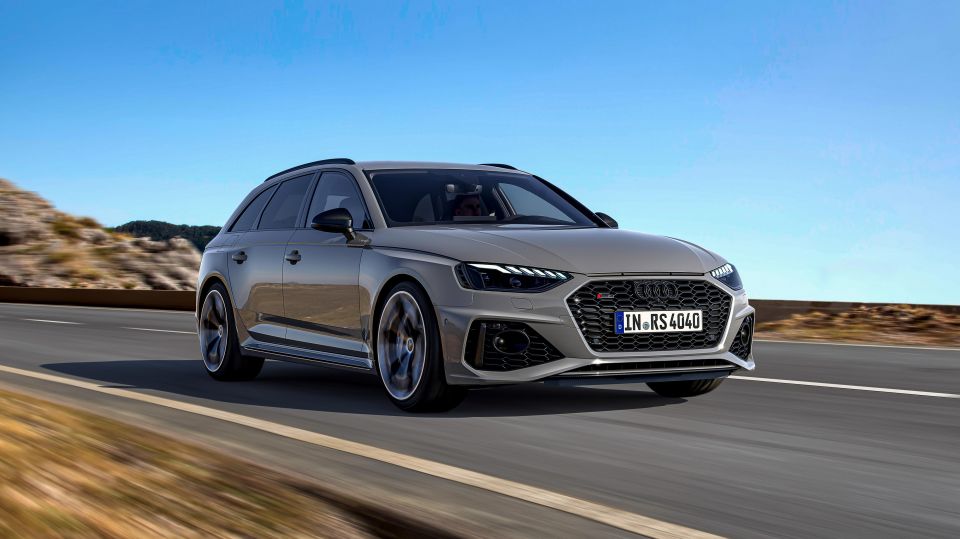
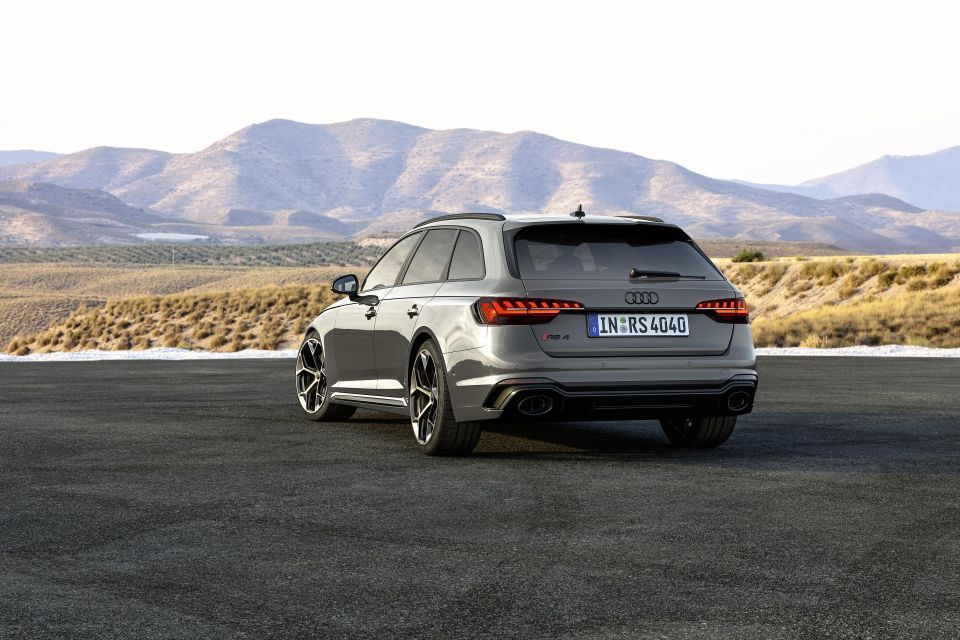

Quickly see how this car stacks up against its competition. Select any benchmark to see more details.
Where expert car reviews meet expert car buying – CarExpert gives you trusted advice, personalised service and real savings on your next new car.
We like the Audi RS4 Avant.
In an era when carmakers around the world are wasting prodigious amounts of R&D money trying to get lumbering SUVs to drive like sports cars, it’s refreshing to find a company that still believes lower and lighter is the obvious answer when it comes to building a load lugger that’s fast and fun to drive.
The facelifted version of the fourth-generation B9 RS4 Avant was launched in late 2020, during myriad COVID-19 lockdowns, so it’s pretty much flown under the radar for all but the most ardent Audi enthusiasts. Especially as the refresh was mostly telegraphed by subtle cosmetic changes such as new LED head- and tail lights.

Though it still looks sharp, the B9, which debuted in 2017, is about to enter the twilight years of its life.
That, and the fact that Mercedes-Benz is about to launch an all-new AMG C63 S E Performance Estate packing a monstrous 500kW and 1020Nm, has prompted what Ingolstadt insiders admit is a last tweak to the RS4 Avant before an all-new model appears in 2025.
That tweak comes in the form of two new optional packages, Competition and Competition plus. Both are designed to make the RS 4 Avant sharper, more responsive, and more engaging to drive.
In simple terms, the Competition and Competition plus packages comprise a series of detailed chassis hardware and software upgrades, plus some small cosmetic changes.
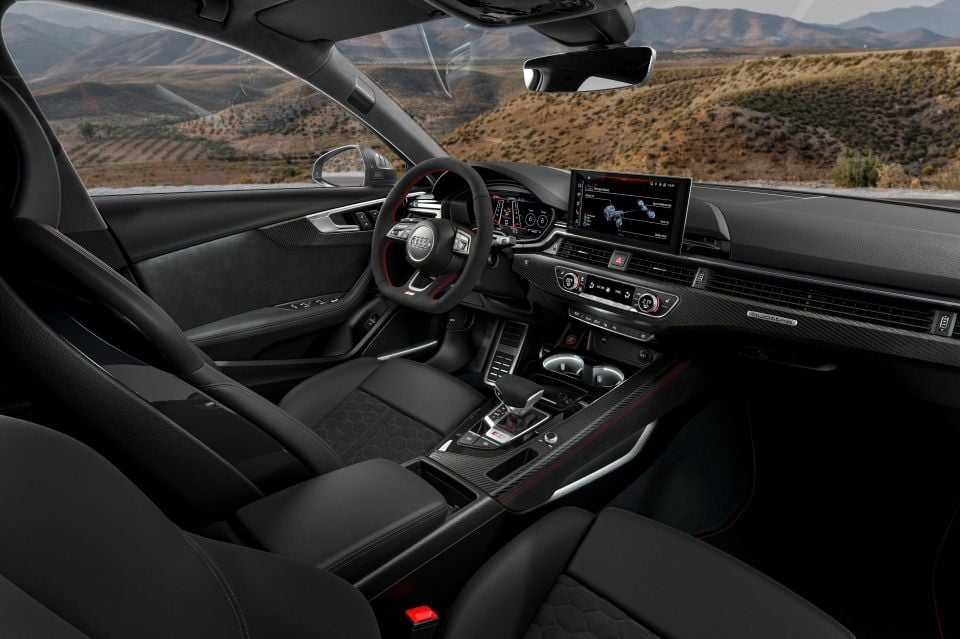
The Porsche-designed 2.9-litre twin-turbo V6 under the RS 4 Avant’s bonnet has been left alone.
Audi Sport insiders say chasing more power from an internal combustion engine in these days of ever tightening emissions and fuel consumption targets would simply cost too much money to generate a return on the investment.
The next-gen RS4 Avant will get a power bump, mainly because of its electrified hybrid powertrain.
But, Audi Sport chassis development chief, Andrei Filip, is convinced that the future of high-performance sedans, coupes, and wagons that can be driven every day lies not in an ultimately futile chase for ever more horsepower, but in improving their dynamic capability, both on the road and on the track.
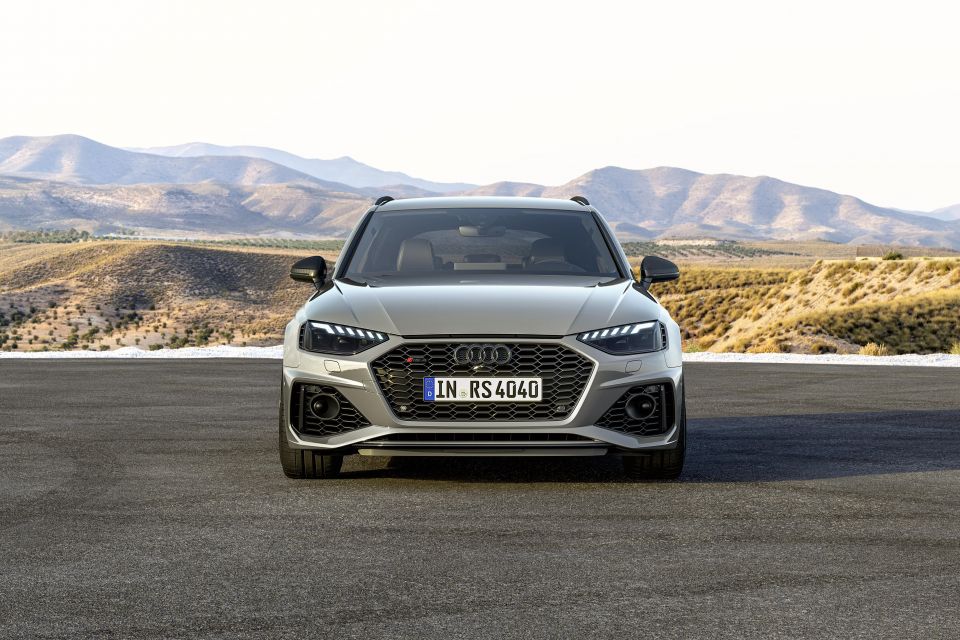
The Competition and Competition plus packages will be offered as options on the RS4 Avant, which currently retails for $156,200 plus on road costs.
Package pricing for the Australian market hasn’t been revealed as yet, but in Europe the Competition package costs €7875 ($12,095), while the plus package adds €11,875 ($18,238).
What do you get for the money? The Competition package unlocks a top speed of 290km/h, more noise from the RS sports exhaust system, and adds new 20-inch alloy wheels that are 2kg lighter than the regular items. Standard tyres are 275/30 front and rear, with ultra-grippy Pirelli P Zero Corsas available as an option.
The Competition plus package delivers all that plus a carefully considered selection of serious handling hardware – upgraded quattro sport rear differential, quicker fixed-ratio steering, and RS sport pro suspension with coil-over steel springs on the front axle that is height adjustable and also features adjustable rebound and compression damping.
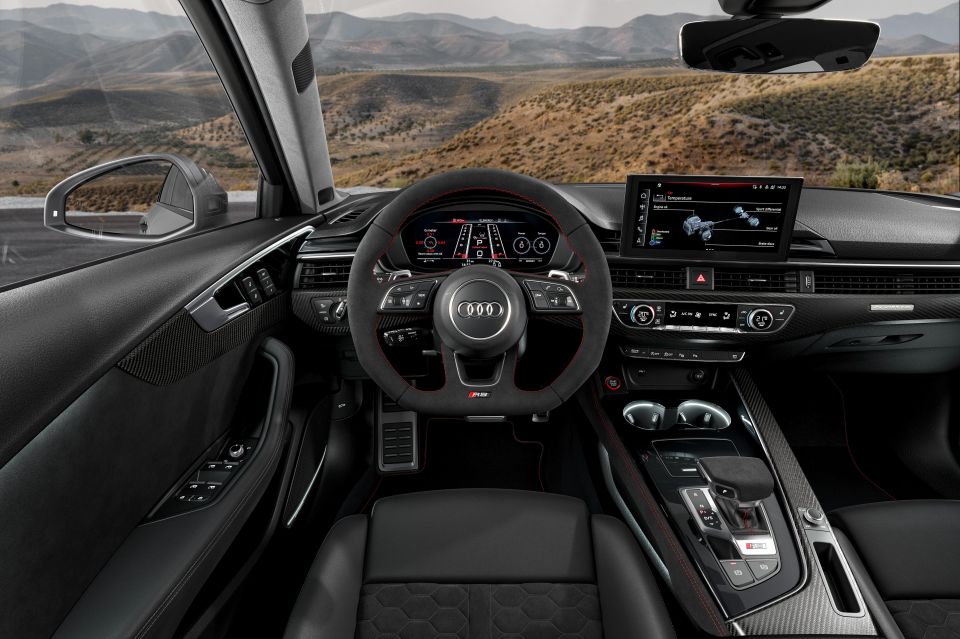
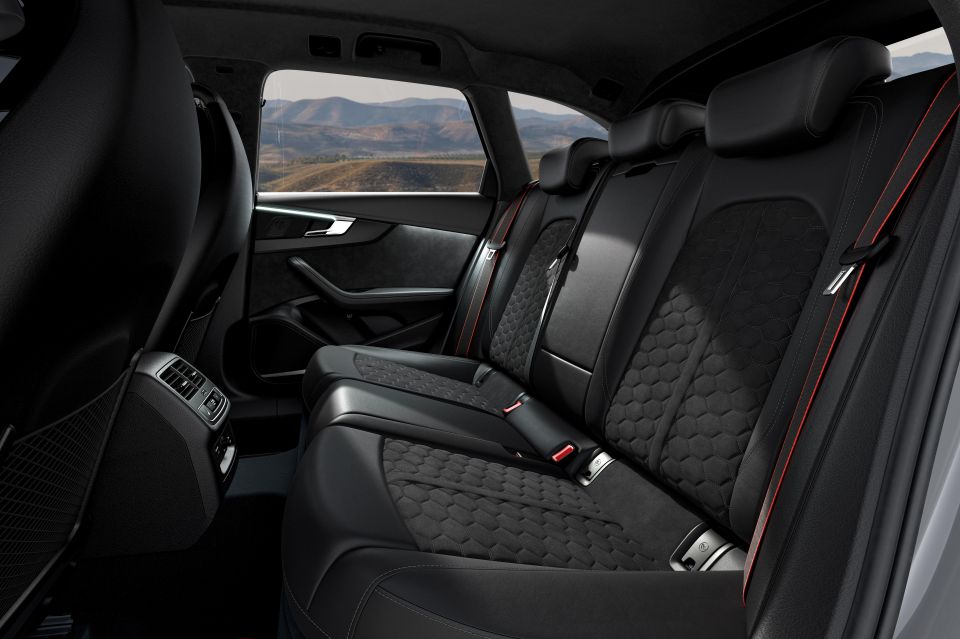
Buy your new car without the stress. It's fast, simple and completely free.

Great service from Travis and team, second time I have used this business would not hesitate to recommend them to anyone
Craig C.
Purchased a Ford Ranger in Sunshine Coast, QLD
CarExpert helped Craig save thousands on his Ford Ranger, now let us save you on your next new car.
Find a dealLike all RS models, the RS 4 Avant interior features Audi’s trademark combination of high-tech functionality with sophisticated forms and materials, overlaid with subtly rendered sporting accents.
The digital instrument panel has unique RS graphics, as does the central infotainment touchscreen over the standard A4 Avant.
Both the Competition and Competition plus packages deliver upgrades over the regular RS4 Avant interior that include seat side panels in piano black and seat belts in black with red edges.
The standard RS sports seats are trimmed in a combination of Dinamica microfibre and leather stitched in the RS honeycomb pattern and embossed with RS logos. The Dinamica material is made of 45 per cent recycled plastic fibres, with about 215 grams of fibre processed per seat.
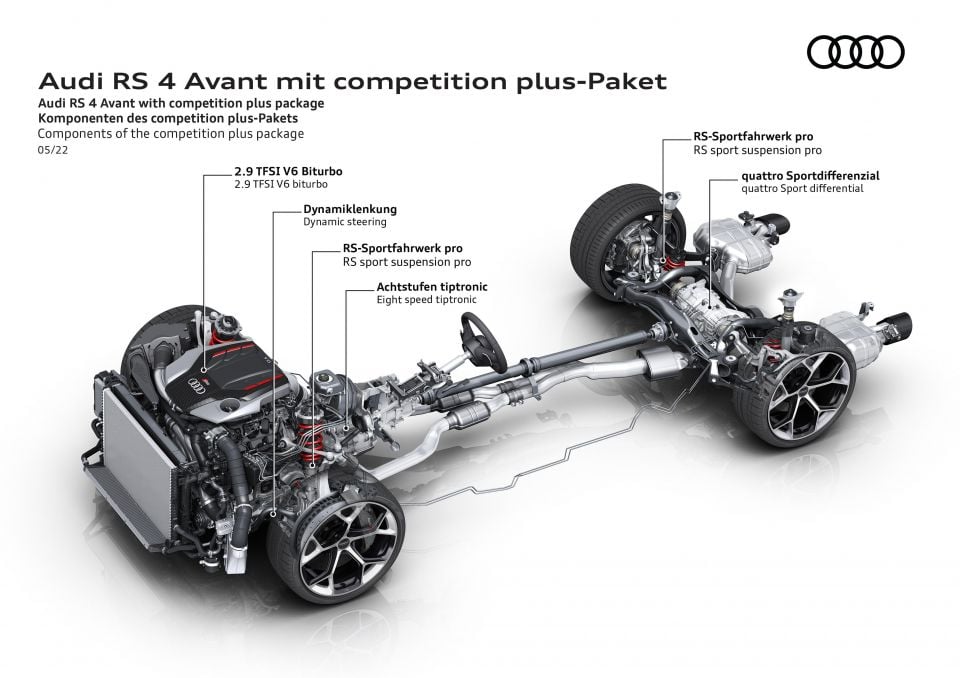
The B9-generation RS4 marked a switch away from two generations of rumbling V8 muscle, and back to the twin-turbo V6 format that powered the original B5 model launched in 1999.
Developed by Britain’s Cosworth Technology, that first RS4 Avant engine featured a capacity of 2.7-litres and five valves per cylinder. It developed 280kW at 7000rpm and 440Nm at 6000 rpm, which was grunt enough to get the B5 RS4 Avant from 0 to 100km/h in 4.9 seconds, and to an electronically limited top speed of 250km/h.
The B9’s V6 was designed and engineered by Porsche, rekindling a link with the RS4 Avant’s legendary ancestor, the B4-based 1994 RS2 Avant, whose 2.2-litre turbocharged five-cylinder engine was reworked by Porsche engineers to punch out 232kW and 410Nm.
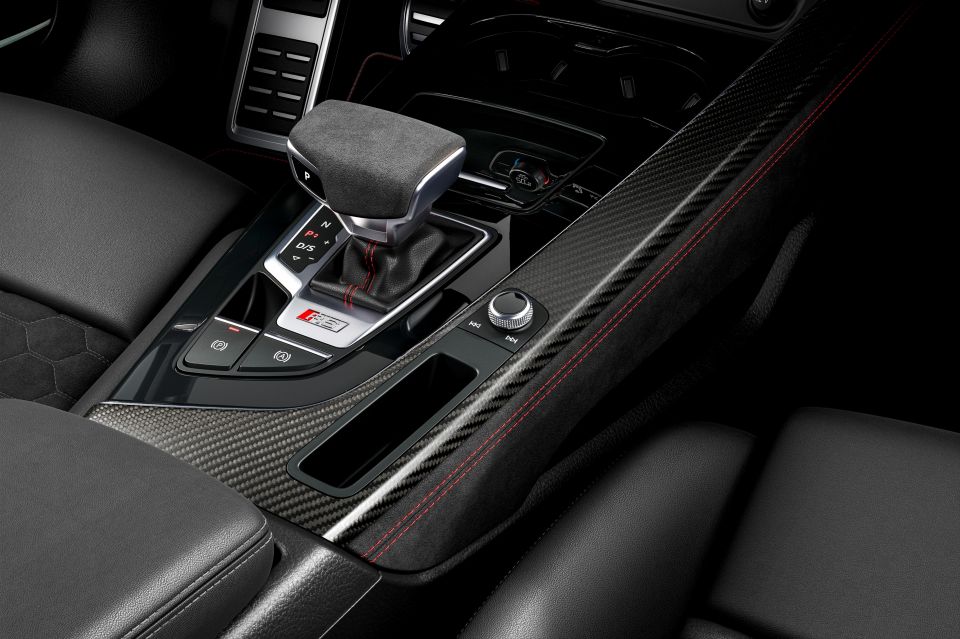
In B9-gen RS4 Avant tune, the 2.9-litre twin-turbo V6 – which also sees duty in the Porsche Panamera S and Cayenne S, as well as the Macan Turbo – pumps out 331kW from 5700rpm to 6700rpm and 600Nm from 1900rpm to 5000rpm. Driving all four wheels through an eight-speed automatic transmission, the engine will scoot the RS4 Avant from 0 to 100km/h in 4.1 seconds.
While all the engine’s hardware is unchanged, as well as its outputs, the remapped software that’s part of the Competition plus package delivers crisper throttle response and faster shifts from the transmission.
That, the stickier Pirelli tyres and the quattro sport differential on the rear axle help shave two-tenths of a second off the regular RS4 Avant’s 0 to 100km/h acceleration time (3.9s).
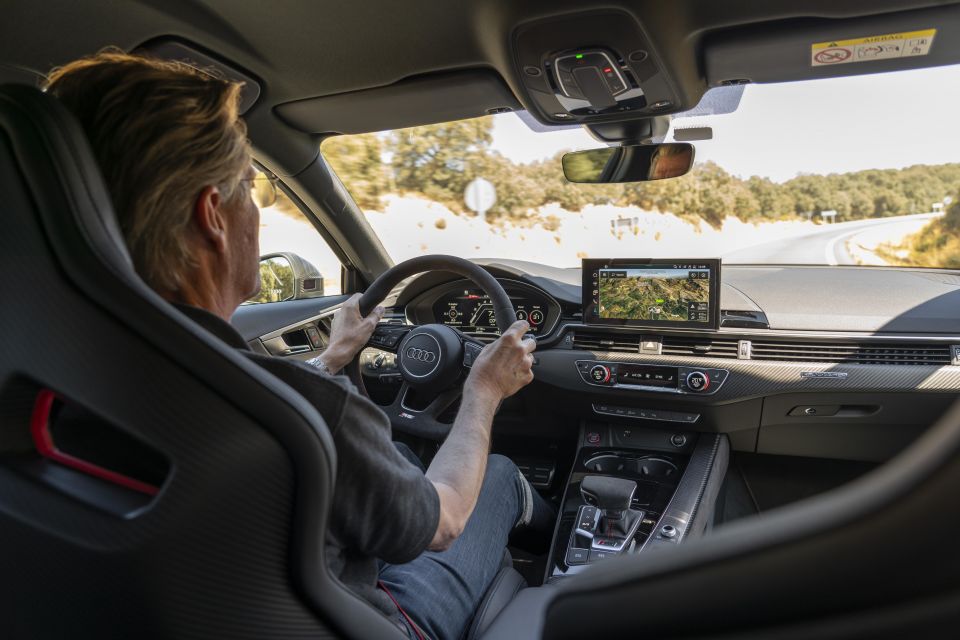
In short, like no other Audi RS 4 Avant in history.
Only a couple of kilometres behind the wheel, and a couple of corners on a country road attacked with brio, and you can feel the extra authority at the front end, and the improved responsiveness of the chassis to throttle inputs.
Driving a front-engined Audi fast has always been an exercise in managing understeer. Not in the RS 4 Avant Competition plus.
“The car is much more precise in the front, and will oversteer more,” says Audi Sport driver Frank Stippler, who was on hand as we hot lapped the Competition plus-equipped RS4 Avant around the fast Ascari Circuit in southern Spain. And he’s right – because everything in the plus package works together beautifully.
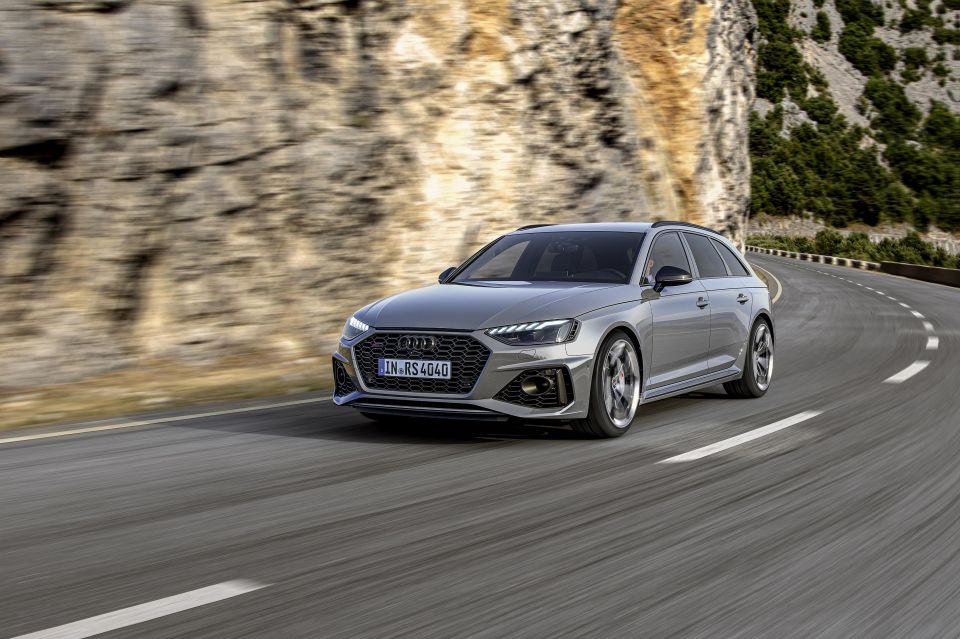
At 13.1:1 the fixed ratio steering is one of the quickest fitted to a current production car, so the front wheels and their 2kg lighter rims and grippy Pirellis react more rapidly to driver input. The more pronounced response dialled into the throttle mapping makes it easier to get the car to rotate when you lift off the accelerator, and easier to catch and hold the rear when you go to power.
What also helps on corner exit is the quattro sport rear differential, which uses clutches to direct most of the torque to the outside rear wheel and punch the RS4 Avant hard out of corners. The stability control has been remapped “so you can have a little more fun”, says Filip, but even with everything switched off the Audi remains easily controllable at the limit.
The Pirelli P Zero Corsas have more rounded shoulders than the standard RS4 Avant tyres to provide better steering accuracy and lateral support, according to Filip, and the compound is so grippy that, with the remapped ABS playing its part, the braking distance to standstill from 100km/h has been shrunk by 2.0 metres.
For the track sessions at Ascari, the adjustable suspension of the RS4 Avant Competition plus was in what Audi Sport engineers call the ‘Nordschleife’ setting.
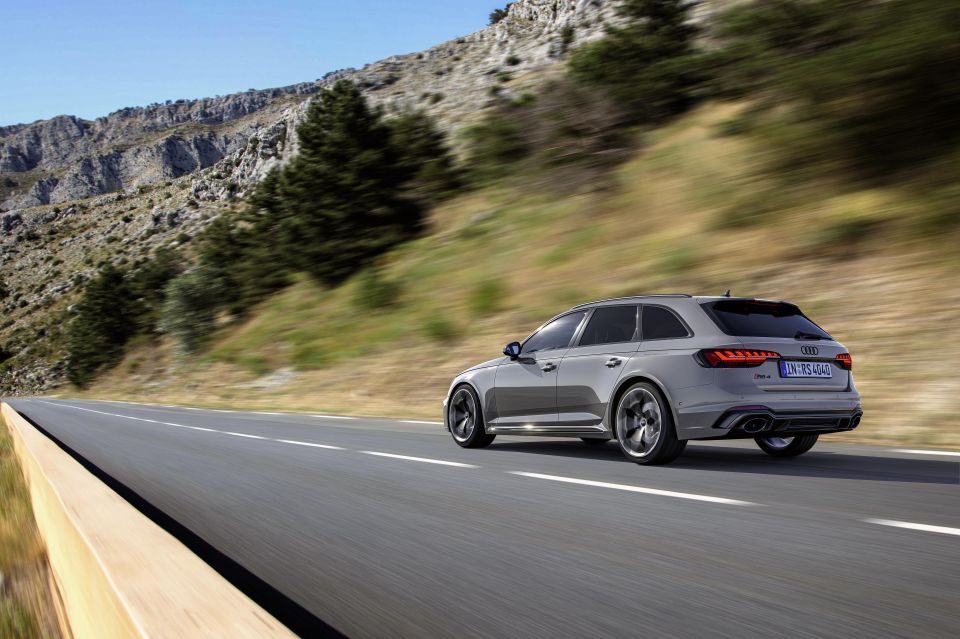
In addition to the damper compression and rebound settings being adjusted to cope with the high speeds, high kerbs and massive compressions that dominate the legendary 20.8km track, this setting also includes a 10mm drop in ride height over the baseline Competition plus setup, which itself is 10mm lower compared with the standard RS4 Avant.
The plus package comes with a manual that includes several recommended settings, and the tools with which you can make the appropriate adjustments.
“We fought long and hard to get the coil-over suspension into Australia,” admits Filip, who says Audi Australia was worried about the lower ride height on our rough roads.
On the road loops in Spain, we drove cars with the suspension in the baseline setting – that is, with a ride height 10mm lower than the regular RS4 Avant chassis – and can confirm that it’s not an issue.
Even when hammering the RS4 Avant Competition plus along roads with humps and hollows that would occasionally get a couple of wheels off the ground, the Audi never once came close to grazing its belly.
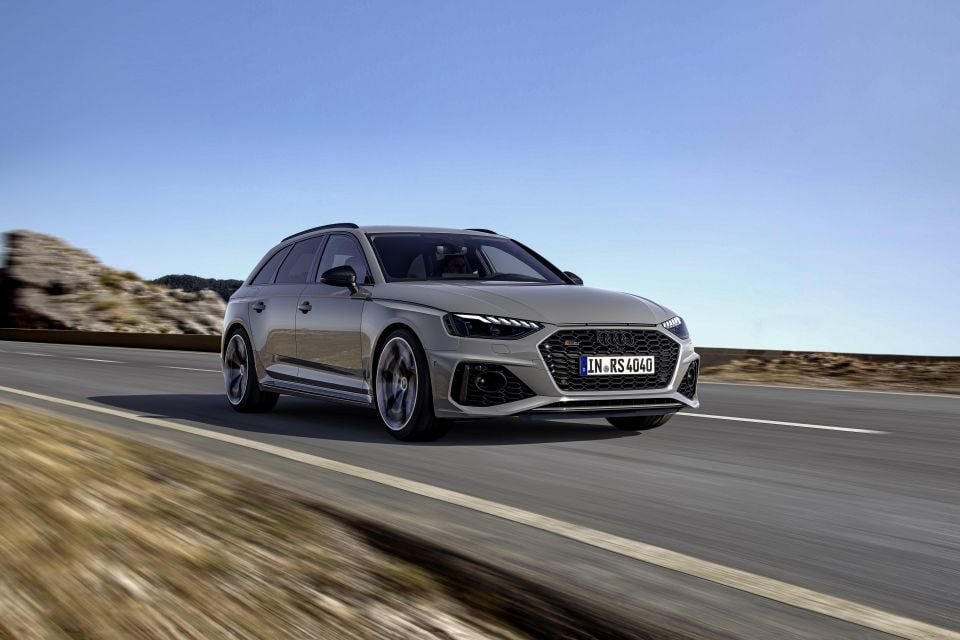
The primary ride is taut, but there’s an analogue feel to the body motions that even the best air suspensions simply can’t match.
Despite those ultra-low-profile tyres, the secondary ride is surprisingly compliant, with little impact harshness felt through the steering wheel or heard in the cabin. That’s impressive when you consider that switching between Comfort and Dynamic modes does not alter the spring or damper rates at all.
Niggles? Though smooth and quiet in Comfort mode around town, the 2.9-litre V6 doesn’t deliver the gut-punch of the old V8.
When you’re hustling in Dynamic mode, with the transmission in the Sport and Manual shift settings, the engine really needs to have at least 4000rpm on board to deliver its best. In tight and twisty stuff, the slightly soft low-end response is exacerbated by the big gap between second and third gear.
If you left-foot brake, you’ll find the engine power cutout activated by pressure on the brake pedal – a safety measure mandated to prevent people who don’t know how to drive from unintended acceleration events – will sometimes prevent your right foot initiating a smooth and early transition to power.
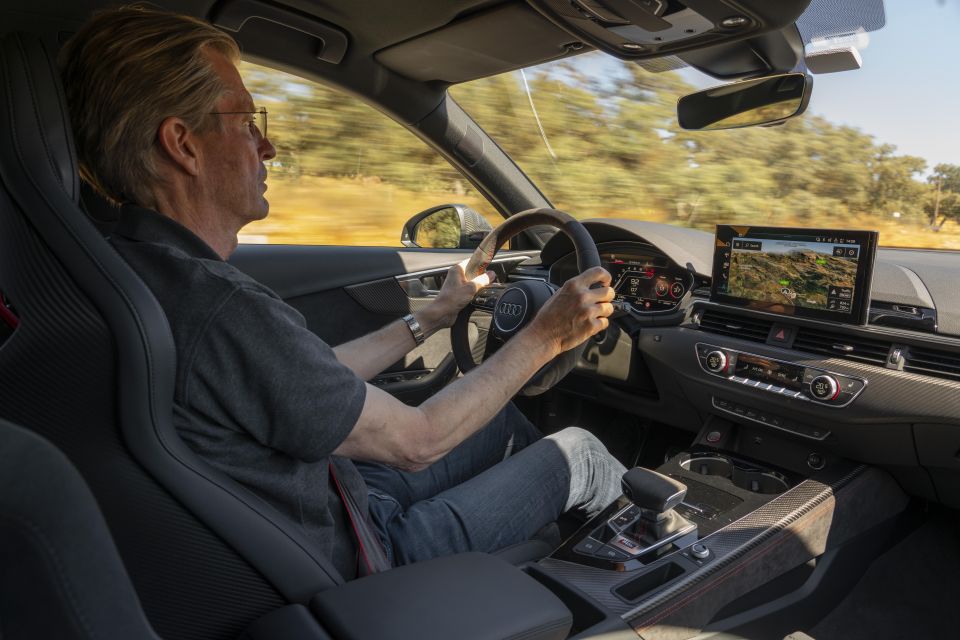
On the subject of brakes, though fitted with massive and unquenchable carbon-ceramic stoppers, the RS4 Avant’s pedal travels a little too far before the pads start gripping the rotors, making it hard to brake smoothly at slow speeds.
Audi’s method of changing drive modes from Comfort to Auto to Dynamic – by toggling a switch on the dash or hunting and pecking at the centre touchscreen – is truly tedious. Fortunately, the RS button on the steering wheel provides a handy shortcut, though you have to punch it twice if you want RS2 mode, which allows you to configure throttle, transmission, stability control and steering settings.
The best setup for fast and fun driving is to dial everything on the RS2 configuration menu to the max, but set the steering to the Comfort setting. It’s a fixed ratio, so nothing changes but the weighting, and in Comfort there’s a lightness and accuracy to the steering that is dulled by the imposition of more weight.
“Heavy steering is for drivers who use the steering wheel as something to hold rather than to control the car,” grumbles Filip, who says the topic is the subject of endless debate among chassis engineers.
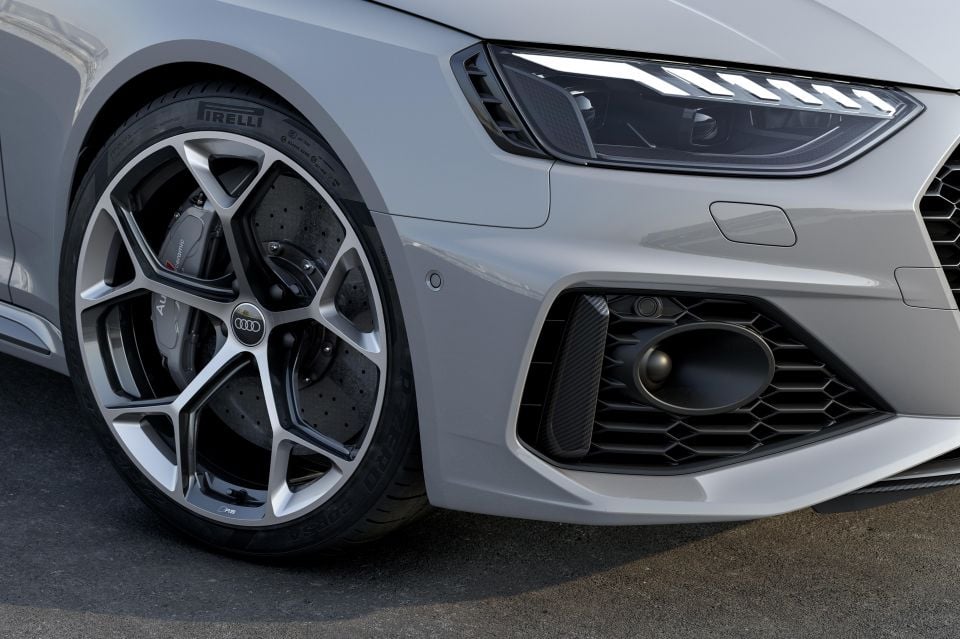
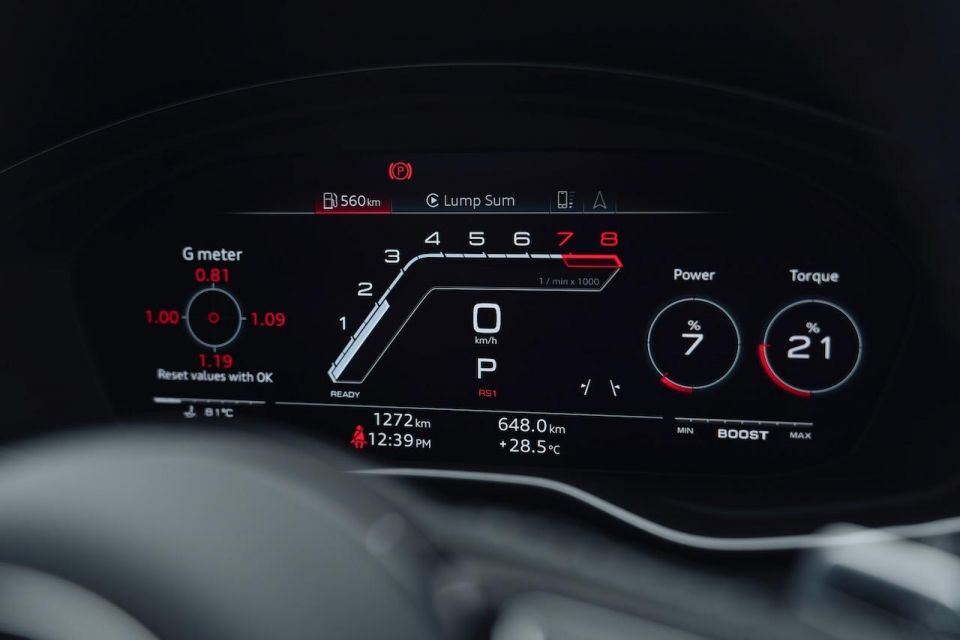

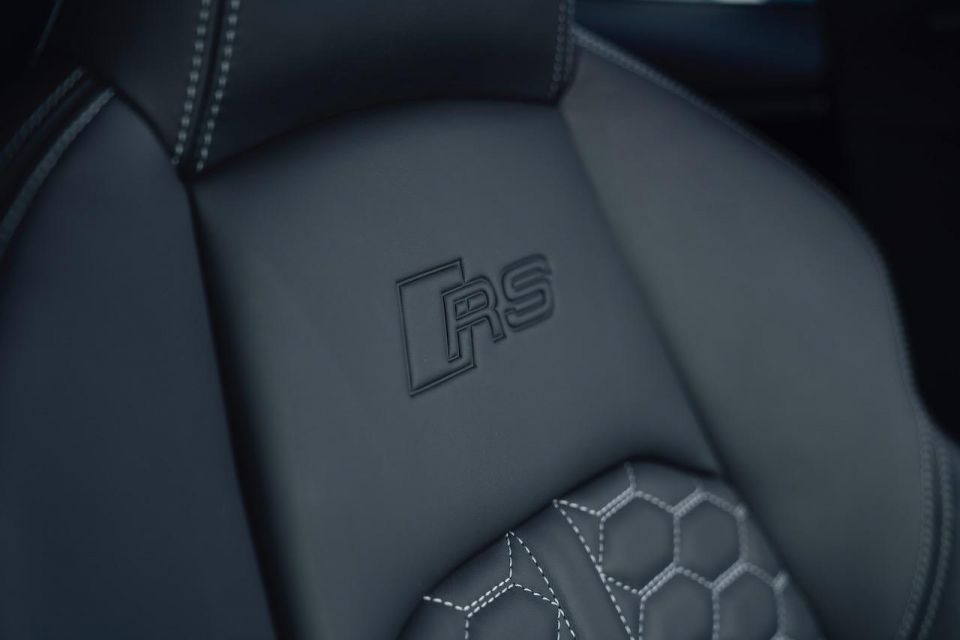
RS4 Avant highlights:
MORE: Audi RS4, RS5 Competition coming to Australia

Where expert car reviews meet expert car buying – CarExpert gives you trusted advice, personalised service and real savings on your next new car.
The current Audi A4 line-up, including the RS4 Avant, is unrated by ANCAP and Euro NCAP as of January 2022.
Why? Euro NCAP and ANCAP introduced a rule that sees ratings expire after seven years or so, and the Audi A4’s previous five-star rating (covering four-cylinder models only) wore a 2015 date stamp.
Standard safety equipment includes:
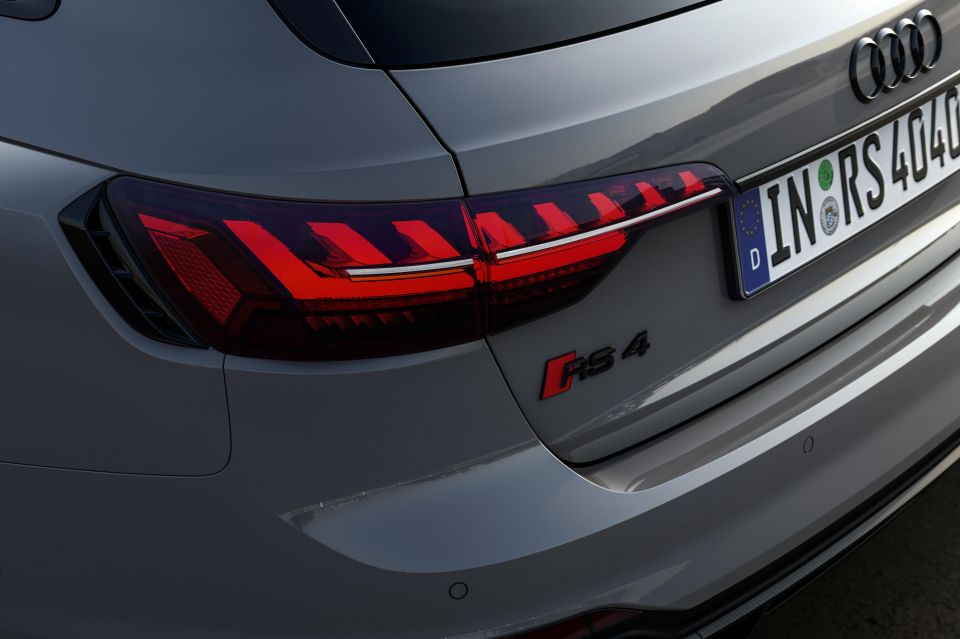
Audi has followed Mercedes-Benz and offers a five-year, unlimited-kilometre warranty on vehicles registered or delivered from January 1, 2022.
The RS4 Avant can also be covered by a five-year service plan that costs $3240.
Service intervals are 12 months or 15,000km – whichever comes first.
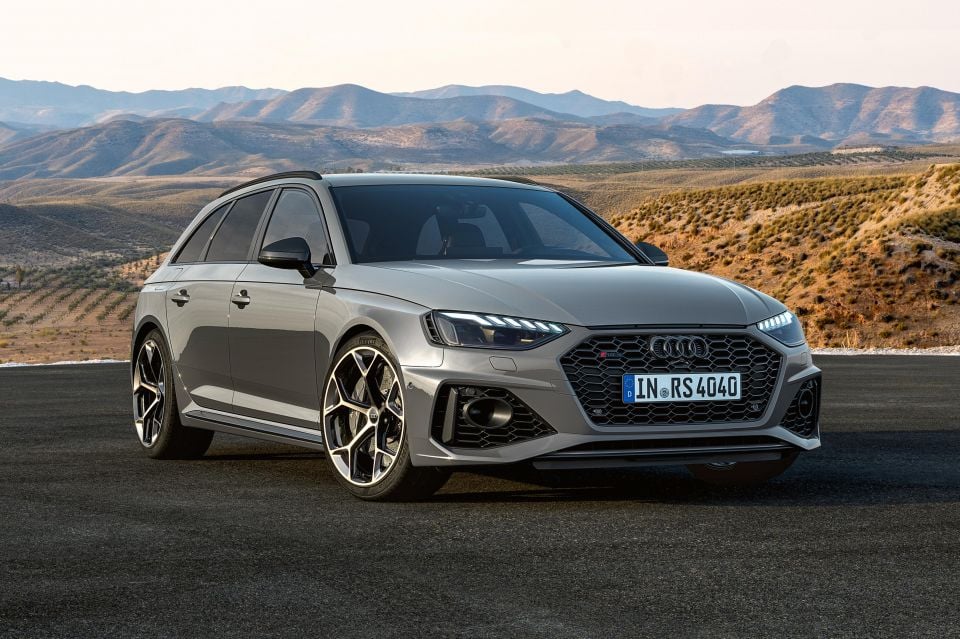
The Audi RS4 Avant is the thinking person’s performance car; fast and fun to drive when you want it to be, yet a surprisingly useful and practical load lugger when you need it to be.
The Competition plus package makes the RS4 Avant slightly faster and much more engaging to drive, without compromising the everyday practicality that makes it desirable.
It’s worth every cent, because it delivers the critical pieces of hardware – and associated software – that transform this hi-po Audi wagon’s handling.
We like the Audi RS4 Avant. But we like the Audi RS 4 Avant Competition plus a lot more.
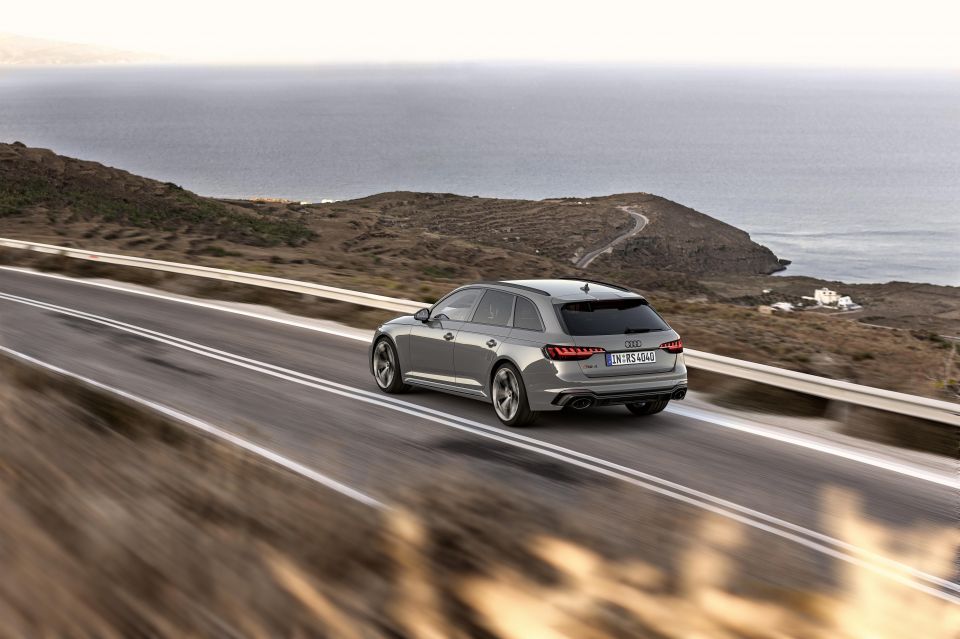
Click the images for the full gallery
MORE: Everything Audi RS4
Where expert car reviews meet expert car buying – CarExpert gives you trusted advice, personalised service and real savings on your next new car.


William Stopford
13 Hours Ago


Ben Zachariah
14 Hours Ago


Derek Fung
15 Hours Ago


Matt Campbell
21 Hours Ago


William Stopford
2 Days Ago


Josh Nevett
2 Days Ago